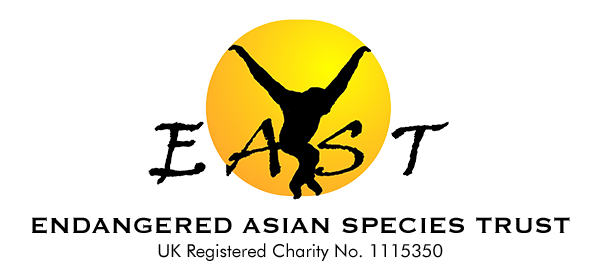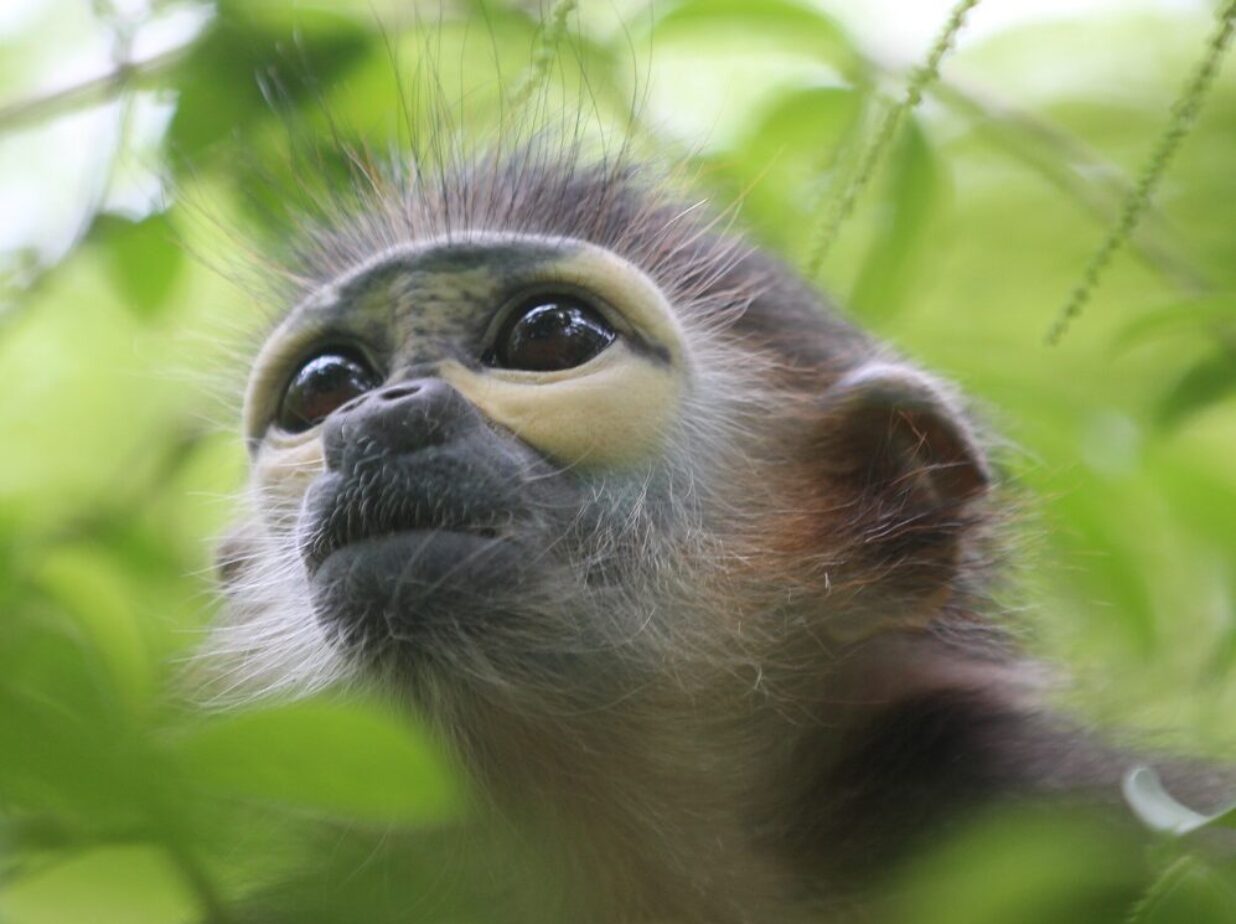Our first douc arrived on Dao Tien in 2008 named Toastie. We kept her warm with skin contact, rehydrated her, she fed well, we let her rest… but she did not wake up. Over the years we have learnt that you cannot let newly rescued infants sleep too much. For the first 48 hours you have to be kind but ruthless. Rehydration and stimulation are crucial. Douc need a reason to live. This comes in two main forms: the forest and others of their own kind. They need to see a familiar world. Running in parallel to this we have evolved protocols for the management of the gut and lungs. Diarrhoea is never a good sign for anyone, but it is very serious for douc. What keeps our primate care staff the happiest is when you have a smelly infant. The familiar burp, stomach gurgle and fart of a healthy douc is not a nice smell, but we love it. It is the sign of a healthy gut and that means we are in with a chance of survival.
With La La, a healthy infant douc rescued in 2012, we got her to release stage at 2.5 years old. We tried to release her with the existing group on Dao Tien; Thanh’s family. But the day before release, even with 24 hour supervision, at 4am a squeak and struggle for a minute was heard, then nothing more. At sunrise La La was dead and a large, reticulated python was sitting next to her trapped in the cage. After swallowing La La the snake spat her out as she was too large. The python had broken the feeding hatch to squeeze in and kill her. Over the years singular douc arrived, often barely alive or with broken bones or teeth marks. Some survived a few weeks, then ultimately the lungs and gut became a problem, they become sleepy and fade away. A little broken, we picked ourselves up and carried on.
Then in 2019 we rescued several douc, one after the other. Anthony, Me, Luom, Vu, Anna and Red. With lots of little douc, we started to see a side to them we had yet to understand, and suddenly appreciated how fundamentally important they are for each other. Douc need douc. They live in the wild in small groups that come together as large super groups of over 60. Douc youngsters are never alone, never far from another douc, a mother, or an aunty who will care for them. We saw fabulous kinship, friendship, hierarchies and douc play – even something so like our own blinds man’s buff. These gentle yet clever small primates suddenly displayed their true colours, their true characters- it was beautiful.
The years passed, the infants went into the trees every day to eat leaf, bark, and soil. But we noticed Anthony, the oldest approaching three years old, was very thin following a growth spurt. The leaves alone were just not enough, and we battled to save him. We lost him to total organ failure. Anthony helped us understand douc so much while he lived, and from valuable post mortem he helped us more after he had passed. Thank you Anthony. Feeling somewhat broken again we carried on, only to soon lose Luom to pneumonia. He was always the weaker one, arriving with huge physical and mental damage after living on a shelf with a chain and repeatedly falling off, hanging by his neck until the person keeping him illegally put him back. He had gone off with his friends to play, when a freak storm passed through. The Dao Tien team brought them in and dried them, but that night South Vietnam had one of the coldest night temperatures on record. All the Loris went into torpor, and Luom became sick and died within 48 hours.
Reeling from his loss and feeling more broken than ever, we adjusted protocol: we introduced more to the diet than leaf – being careful to keep the leaf-eating gut safe. We introduced heaters on monitors if the temperature dropped in the cold season. We continued to read any published data on douc, we questioned rangers for their observations of wild douc – what do they eat in addition to leaf? Lots of seeds, nuts, lichen & bark… and we continued improving our protocols.
Then Peter arrived, a super skinny adolescent douc. We now had the nutritional knowledge, as well as social knowledge. He lived and thrived. From just under 4 kg he bloomed to nearly 9 kg. At last we thought, a possible release candidate. Peter lived at least his first two years in the wild and had better knowledge than our other douc like Anna, Red and Quy, who arrived Dao Tien as tiny infants.
It was time to plan for a douc release. This time a strong adult, tracking his every move post-release.
We had to know if he survives, how he behaves. With any release there is risk, but we had to try. Living next to wild populations, you see the difference between captivity and the wild. It does not compare. We needed to be brave and give him a chance. With constant improvement in technology, satellite collars (which 10 years ago weighed over 500g, now weigh 170g) are now light enough for a douc to carry. Peter could be a trailblazer for other douc; if Peter does well, others like Vu & Anna and douc in other centres could follow.
After lots of preparation, in June 2024 Peter was fitted with a GPS/Satellite collar and released back to the wild on Dao Tien. We monitor him daily via a phone app that shows the GPS points of his movements. Our field team, using a VHF beacon, go daily and see him to ensure he is healthy and take the opportunity to see what he is eating.
He has met other douc, he is travelling well, and he is getting fitter. His large legs now are muscular and he leaps just like the wild douc. The final stage for him is to bridge the river in the dry season and head deeper into Cat Tien Forest. It is normal for male douc to travel on their own, or form a small band of similar males. Every day we observe Peter, smile and, importantly, learn. He still has more to do… but we will hopefully shadow him all the way until July 2025 when the collar drops off. We are rooting for you, Peter. This means so much to us all.

